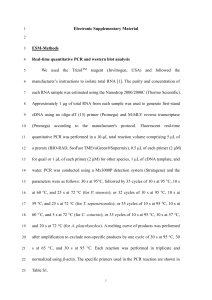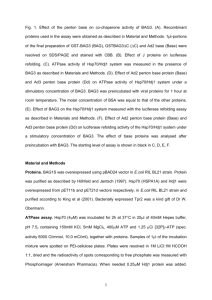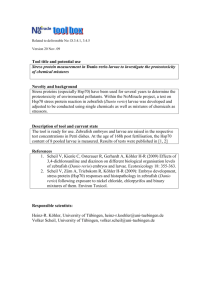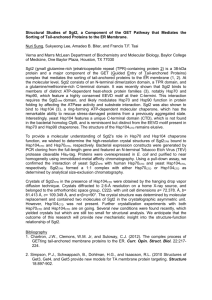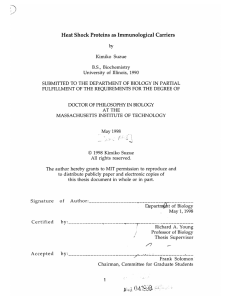S Heat Shock Proteins Developing a tool to fight
advertisement
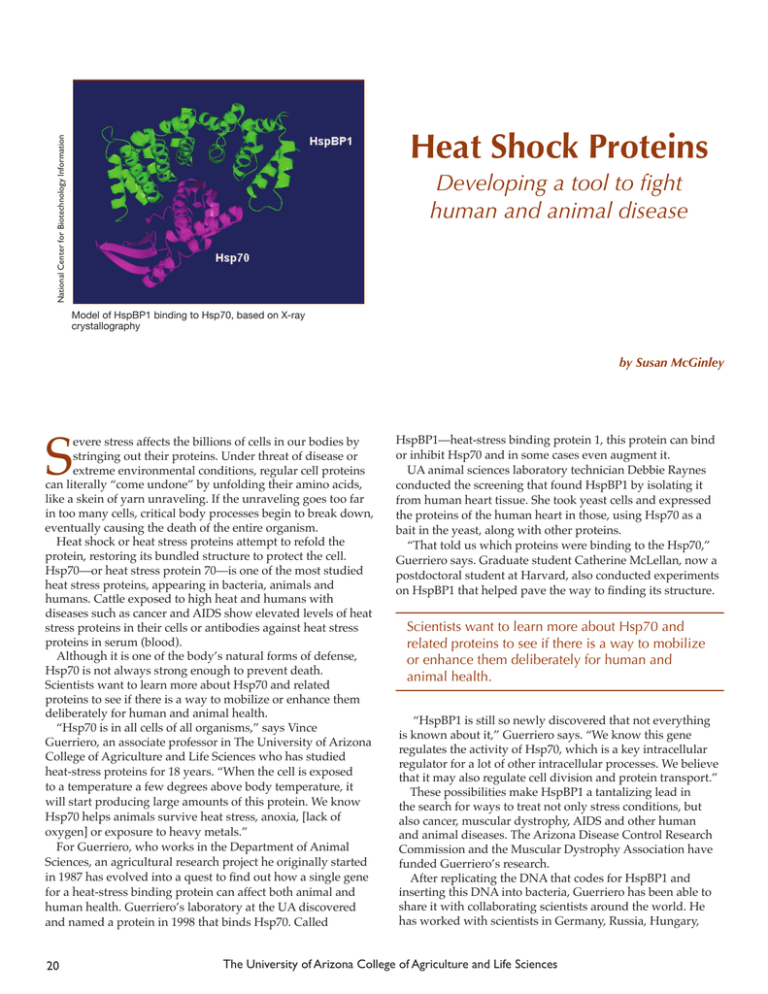
National Center for Biotechnology Information Heat Shock Proteins Developing a tool to fight human and animal disease Model of HspBP1 binding to Hsp70, based on X-ray crystallography by Susan McGinley S evere stress affects the billions of cells in our bodies by stringing out their proteins. Under threat of disease or extreme environmental conditions, regular cell proteins can literally “come undone” by unfolding their amino acids, like a skein of yarn unraveling. If the unraveling goes too far in too many cells, critical body processes begin to break down, eventually causing the death of the entire organism. Heat shock or heat stress proteins attempt to refold the protein, restoring its bundled structure to protect the cell. Hsp70—or heat stress protein 70—is one of the most studied heat stress proteins, appearing in bacteria, animals and humans. Cattle exposed to high heat and humans with diseases such as cancer and AIDS show elevated levels of heat stress proteins in their cells or antibodies against heat stress proteins in serum (blood). Although it is one of the body’s natural forms of defense, Hsp70 is not always strong enough to prevent death. Scientists want to learn more about Hsp70 and related proteins to see if there is a way to mobilize or enhance them deliberately for human and animal health. “Hsp70 is in all cells of all organisms,” says Vince Guerriero, an associate professor in The University of Arizona College of Agriculture and Life Sciences who has studied heat-stress proteins for 18 years. “When the cell is exposed to a temperature a few degrees above body temperature, it will start producing large amounts of this protein. We know Hsp70 helps animals survive heat stress, anoxia, [lack of oxygen] or exposure to heavy metals.” For Guerriero, who works in the Department of Animal Sciences, an agricultural research project he originally started in 1987 has evolved into a quest to find out how a single gene for a heat-stress binding protein can affect both animal and human health. Guerriero’s laboratory at the UA discovered and named a protein in 1998 that binds Hsp70. Called 20 HspBP1—heat-stress binding protein 1, this protein can bind or inhibit Hsp70 and in some cases even augment it. UA animal sciences laboratory technician Debbie Raynes conducted the screening that found HspBP1 by isolating it from human heart tissue. She took yeast cells and expressed the proteins of the human heart in those, using Hsp70 as a bait in the yeast, along with other proteins. “That told us which proteins were binding to the Hsp70,” Guerriero says. Graduate student Catherine McLellan, now a postdoctoral student at Harvard, also conducted experiments on HspBP1 that helped pave the way to finding its structure. Scientists want to learn more about Hsp70 and related proteins to see if there is a way to mobilize or enhance them deliberately for human and animal health. “HspBP1 is still so newly discovered that not everything is known about it,” Guerriero says. “We know this gene regulates the activity of Hsp70, which is a key intracellular regulator for a lot of other intracellular processes. We believe that it may also regulate cell division and protein transport.” These possibilities make HspBP1 a tantalizing lead in the search for ways to treat not only stress conditions, but also cancer, muscular dystrophy, AIDS and other human and animal diseases. The Arizona Disease Control Research Commission and the Muscular Dystrophy Association have funded Guerriero’s research. After replicating the DNA that codes for HspBP1 and inserting this DNA into bacteria, Guerriero has been able to share it with collaborating scientists around the world. He has worked with scientists in Germany, Russia, Hungary, The University of Arizona College of Agriculture and Life Sciences Korea, England, France, Italy, Japan, and the United States by mailing the DNA, proteins and antibodies back and forth, and corresponding through email. For example, to define the structure of HspBP1, Guerriero sent the protein and DNA to the Max Planck Institute in Germany, where it was analyzed through X-ray crystallography to reveal a distinctive shape that made the cover of the journal Molecular Cell in February 2005. The confirmation or structure of a protein dictates its function. In this case, Hsp70 and HspBP1 turned out to be wrapped around each other, implying a close interaction in their functions. Hsp70 is known as a “chaperone protein” that refolds proteins. According to research in the Guerriero lab, HspBP1 is a “co-chaperone” protein that regulates Hsp70. It does this by binding or blocking its action; by changing the confirmation or shape of the physical connection it shares with Hsp70; and by inhibiting Hsp70associated protein folding. The three-dimensional form gave Guerriero something to work with to understand the chemical bonds involved. These possibilities make HspBP1 a tantalizing lead in the search for ways to treat not only stress conditions, but also cancer, muscular dystrophy, AIDS and other human and animal diseases. “Before you can do anything, you need to know the rules, how this system works,” Guerriero says. “It can be used as a tool once we know more.” To test the model, Guerriero and his colleagues have been altering protein interactions in the laboratory by inducing stress in animal cells and then adding Hsp70 and HspBP1 to influence the folding and unfolding of the proteins. They’ve tried binding the two proteins tighter or looser in different disease scenarios, alternately inhibiting and stimulating them to understand more about how they work. In the case of proliferating diseased cells, they are looking for ways to disable them. “It’s very well known that cancer cells have abnormally elevated levels of Hsp70, and viral replication and viral infection are dependent on Hsp70,” Guerriero says. Using another approach against cancer, Guerriero’s team is collaborating with the Institute of Gene Biology at the Russian Academy of Sciences in Moscow, and with another group in St. Petersburg, to study a protein that is lethal to cancer cells. This protein requires the presence of Hsp70 to kill the cells, so in this case HspBP1 actually blocked the activity of the lethal protein. The researchers want to know how the system works and if it can be used in cancer therapy. Through a collaboration with members of the UA Departments of Nutrition and of Veterinary Science and Microbiology, Guerriero found that HspBP1 and antibodies against HspBP1 are actually present in human sera. These studies have been expanded with a group in Hungary that recently reported that antibodies against HspBP1 are elevated in patients infected with HIV. Such a correlation opens the possibility for new understanding of how this virus works. Although Guerriero initiated his research nearly two decades ago to understand how livestock can adapt to heat stress, it’s clear that the results have led to many new and exciting areas involving applications to human medicine. “There are a lot of exciting paths to go down, and we’re trying to take them one at a time,” he says. “Anything we find is new.” Catherine McLellan The same binding protein in cells under heat-stressed conditions (below) “It’s very well known that cancer cells have abnormally elevated levels of Hsp70, and viral replication and viral infection are dependent on Hsp70,” Guerriero says. “If you could drop those levels then this may be a method of controlling these two processes.” One idea is to use the binding protein to disable Hsp70 in the cancer cells only, which would kill them. He is beginning to test ways to introduce the HspBP1 into cancer cells or to increase the levels that are already there, and to alter its amino acids to make it a better inhibitor. In one study, Guerriero and his colleagues found that levels of HspBP1 in tumors are actually elevated but not powerful enough to inhibit Hsp70 throughout the cell. However, they were elevated enough in tumor cells to be a new cancer marker. HspBP1 localization in cells under non-heat-stressed conditions (above) CONTACT Vince Guerriero 520-621-7764 guerrier@email.arizona.edu 2005 Agricultural Experiment Station Research Report 21
